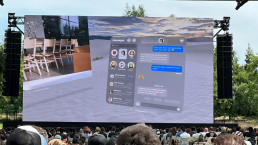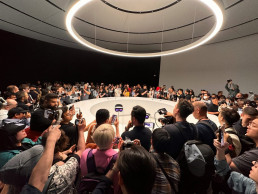Several years since the introduction of watchOS in 2014, Apple is once again setting its sights on revolutionising a technology that has yet to fulfil its potential. While augmented reality (AR) and virtual reality (VR) are not new, they have been subject to the unpredictable nature of product launches, with numerous companies transitioning from pioneers to underachievers in double quick time.
Nearly 350 AR and VR headsets have been launched in the past 10 years. Each brand has presented its own vision of AR and VR, only to fall short of lofty expectations. How many times have we eagerly embraced a new device, anticipating its transformative impact on our lives, only to be swiftly let down again and again?
Why will it be different this time? And why is this announcement so important?
The Revolution of Technology
The significance of this announcement lies in the anticipation surrounding tech companies’ efforts to revolutionise the next generation of user interfaces.
Throughout much of the latter half of the 20th century, keyboards were the primary means of interacting with digital content. But we have since witnessed the rise and widespread adoption of the mouse, touch interfaces, multitouch, voice control and voice assistants, with Apple playing a leading role in advancing some of these. Over the years, various organisations have explored immersive technologies and in the past decade VR and AR have become accessible to both consumers and businesses.
No single consumer electronics brand has managed to truly transform our interaction with digital content, however. This is what Apple aims to achieve with the Vision Pro — and it has started with a bang.
Why Vision Pro Is a Game-Changer
I was lucky enough to experience the Vision Pro hands-on. This is a product that truly lives up to the expectations set out in the keynote. Every aspect of the device is extraordinary: the image quality, the eye tracking and hand gestures, the immersive 3D spatial photos and content, the FaceTime conversations with 3D holograms, the way it blends the virtual with the real world through EyeSight, the user-friendly interface, and the luxurious feel of a meticulously crafted device.
With the Vision Pro Apple has revolutionised AR and VR experiences with a device that surpasses any other headset I’ve ever tested. This ground-breaking product has propelled the world of augmented and virtual reality to a completely different level.
Over the past decade, the collective expenditure on VR and AR headsets has exceeded $21 billion, while the number of headsets shipped has reached 59 million. The market is poised for even greater expansion, thanks to Apple’s entrance, which is expected to ignite widespread adoption and compel competitors to enter the segment.
We forecast that combined shipments of AR, VR and mixed-reality (MR) devices will skyrocket to 97 million units between 2023 and 2027, generating estimated revenue of $49 billion.
Vision Pro Potential in Business
While Apple emphasised its consumer-focused approach during the keynote, the company must expand its vision beyond just the consumer segment. Gaming has traditionally dominated the VR landscape, and this is likely to continue in the coming years. But there is an emerging potential for commercial applications as enterprises seek ways to minimise expenses and enhance customer satisfaction. By 2027, training, collaboration and improving customer experience will account for more than 52% of overall expenditure on MR hardware.
Similarly, AR has predominantly catered to enterprise users for troubleshooting, product development and design purposes. But there is also a rising consumer market opportunity for personal productivity and entertainment.
To realise this potential, Apple will need to mobilise its extensive developer community. Given the large community of developers, the company is well positioned to drive content creation through its developer base, which will be pivotal in reaching a significantly broader customer base.
Vision Pro Is Expensive — But the Benefits Are Clear
The Vision Pro is not cheap, but focusing only on its cost overlooks the main benefit. The product is not designed to generate long lines outside stores on launch day.
Instead, it will be a platform for content creators to unlock their creativity and seize new opportunities. Just as the iPad empowered developers to leverage a larger screen for innovative applications, the Vision Pro delivers a flawless, intuitive and immersive experience to end users — critical for developers to focus on content opportunities and not on product glitches.
Developers want a device that enables them to offer premium and familiar experiences to users, while enterprises see the potential of MR in reducing costs across areas such as product development, training, industrial maintenance and emergency response. Embracing MR can also enhance collaboration and improve customer experiences.
Enterprises and developers need a high-quality device with exceptional specifications that empowers them to deliver outstanding experiences, all while minimising costs. The Vision Pro does just this.
For consumers, the Vision Pro offers innovative ways to engage with digital content. Although we can access content on various screen sizes, an exceptional experience often requires the optimal screen size. This often leads to compromising mobility to enhance the experience, as only smartphones, iPads and laptops offer truly mobile screens.
For instance, while movies can be enjoyed on smartphones, a larger screen in a theatre provides a significantly better viewing experience. In the workspace, working with multiple displays boosts productivity compared to relying on a single laptop screen. But users can’t be carrying multiple screens when they change locations. AR experiences can also be accessed via smartphones or tablets, but the ability to view content hands-free is a major enhancement to the overall experience.
For years, MR headsets have promised such features. The ability to individually access all desired displays for each specific experience is not a novel concept. But while other companies have made promises and only partially delivered on them, primarily in gaming and in limited commercial applications, Apple is now delivering what many players in the space acknowledge only it can deliver.
Three Improvements for Vision Pro?
Despite its disruptive nature, there is still room for improvement with the Vision Pro:
- After using it for 30 minutes, I found myself wondering whether I could comfortably wear the device for a few hours. It was heavier than I’d thought, though that’s understandable considering the advanced technology it incorporates.
- Another consideration is that the device essentially “glues” a screen to our eyes, so eye fatigue could be an issue. Users should be careful and look at ways to minimise discomfort during prolonged use.
- Personal interactions. While EyeSight is one of the headset’s standout features, enabling users to connect with others without having to remove the device, it does raise practical concerns. How many of us would truly engage in conversations by displaying a digital representation of our eyes? This may require further evaluation to determine its real-world utility and acceptance.
In summary, Apple has been a disruptive force across multiple categories and industries, transforming personal computers, music players, smartphones and watches, to name a few. Its innovative products have not only set the standard for their respective categories, but have also revolutionised our lives in unimaginable ways.
With the introduction of the Vision Pro, Apple is initiating the next revolution in personal technology.
Please reach out if you have any questions, or follow me on Twitter or LinkedIn.



